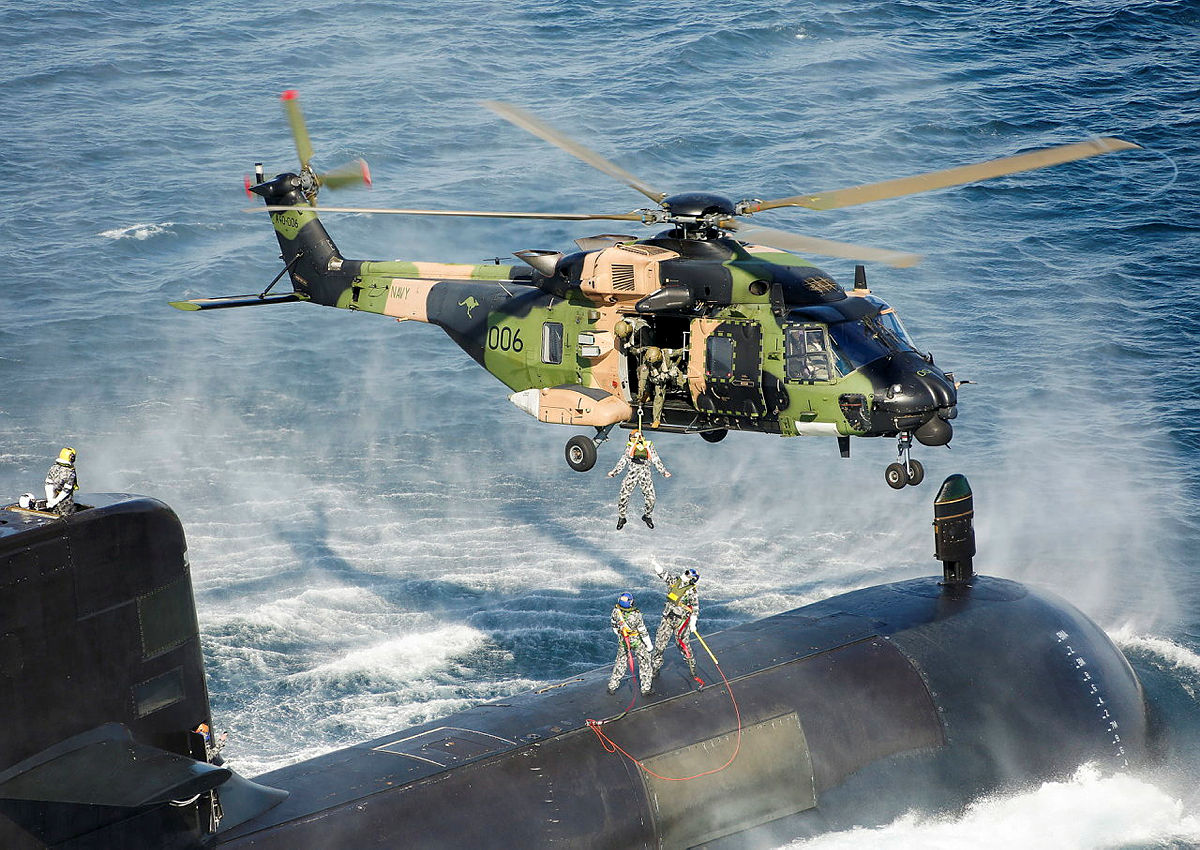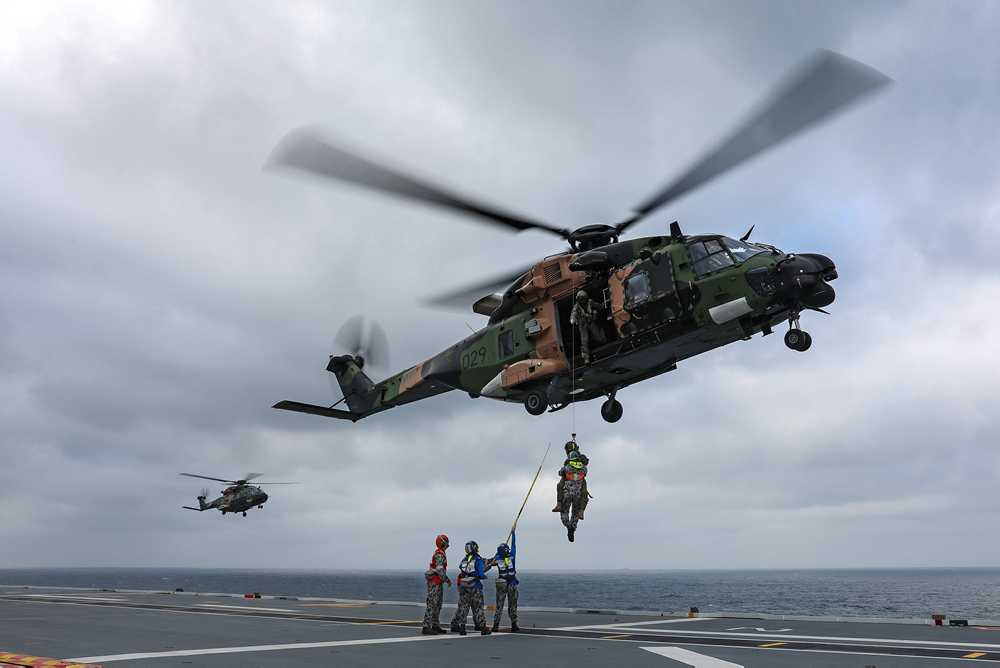During the high-profile military exercise involving troops from multiple countries, including the US, an Australian MRH-90 Taipan helicopter, known for its track record of accidents and malfunctions, tragically crashed into the waters near the country’s northeast coast.
On the night of July 28, at approximately 10:30 pm, a European-designed MRH-90 Taipan helicopter carrying four crew members crashed into waters off Hamilton Island while participating in a two-helicopter training mission.
As a part of the Exercise Talisman Sabre Exercise, the ill-fated helicopter was undertaking a night-time non-tactical flight referred to as a ‘green move.’ Accompanying it on this flight was a second chopper, which immediately sprang into action in the aftermath of the crash, commencing search and rescue efforts.
The crashed MRH90 helicopter was part of a diverse airframe task group consisting of personnel and aircraft from Australia, the United States, and New Zealand.
Due to the unfortunate incident, the multinational military exercise, spanning two weeks and involving 30000 soldiers from various nations, was halted.

Search and Rescue efforts are underway to locate the four crew members who went missing following the helicopter crash, Australia’s Defense Minister Richard Marles said on July 29.
“These are early days, and there will be much more information to be provided,” said Marles, who is also the defense minister. “We desperately hope for better news.”
In a joint statement, Australia’s Defense Minister Marles and Prime Minister Anthony Albanese said their thoughts were with the loved ones of the missing personnel.
According to the Australian media, as an investigation is currently in progress, the entire fleet of MRH90 helicopters has been temporarily grounded, leading to the standdown of all aircrew involved, as part of the ongoing investigation.
The crashed aircraft and its crew members belonged to Sydney’s 6th Aviation Regiment, stationed at Holsworthy Barracks.
The Talisman Sabre exercise of this year marked its largest iteration to date, incorporating dynamic live-fire exercises and amphibious landings.
Furthermore, this event coincided with the visit of US Secretary of State Antony Blinken and Secretary of Defense Lloyd Austin to Australia.
The visit of US officials aimed to engage in discussions with Marles and Australian Foreign Affairs Minister Penny Wong, further strengthening the diplomatic ties between the two nations.
The Australian Defense Minister expressed gratitude to the United States for their assistance in the ongoing rescue and search operations.
Australia’s ‘Doomed’ European Choppers
Although the exact cause of this tragic accident remains unclear, it is bound to reignite discussions and concerns regarding the MRH90 Taipan fleet, which has been beset by persistent issues.
Throughout the last few years, the MRH90 Taipan, a helicopter deployed by the Australian Army and the Navy, has been the subject of numerous unfavorable news stories and reports.
Described by Talisman Sabre director Brigadier Damian Hill as a “terrible moment,” the recent crash is not the first incident involving Australia’s ‘Doomed’ European-designed choppers.
During a counterterrorism training exercise in March of this year, a Taipan helicopter carrying ten Australian defense force personnel ditched into the waters near the New South Wales south coast. But the crew members were safely rescued.
The crash was attributed to an engine failure, possibly resulting from outdated software onboard the helicopter. Since their procurement by the Howard government in 2004, the MRH-90 Taipan helicopters have encountered a series of controversies.

A scathing report from the Australian National Audit Office revealed that the government’s choice to acquire MRH-90 helicopters contradicted the initial departmental recommendation for Black Hawks during two phases of the program.
The report highlighted the “unforeseen immaturity” of the Taipan’s design and support system, which posed substantial challenges to their operational readiness. The helicopter’s high running costs also added to the complexity of maintaining a feasible and efficient fleet.
Nonetheless, the Taipan fleet has faced several instances of grounding due to crashes and other operational errors.
In 2010, an MRH-90 Taipan encountered engine failure near Adelaide’s RAAF Edinburgh air base while in flight. Despite successfully landing back at the base with just one engine, this incident resulted in the grounding of the entire Taipan fleet.
In 2019, the fleet faced another grounding to address issues with the tail rotor blades. Then, approximately half of the fleet was once again grounded in 2020 due to problems with some sliding cabin door rails, rendering them unserviceable.
Consequently, Defense Department had to allocate $37 million to hire private helicopters as a substitute for the Taipans, which had low availability.
Late in 2021, the then-Morrison government announced its decision to replace the European-backed Taipans with US-made Black Hawk helicopters. After the 2022 election, the Albanese administration agreed to invest an estimated $2.8 billion to acquire 40 Black Hawks from the US.
Meanwhile, in mid-2022, following Australia’s suit, Norway decided to terminate its longstanding contract with NATO Helicopter Industries (NHI), an Airbus-led consortium of European aircraft and defense manufacturers, to procure 14 NH90 medium-lift helicopters.
The cancellation was prompted by two decades of increasing frustration due to the continuous delays, errors, and demanding maintenance requirements linked to the NH90 helicopters.
- Contact the author at ashishmichel(at)gmail.com
- Follow EurAsian Times on Google News




